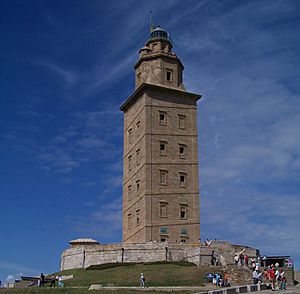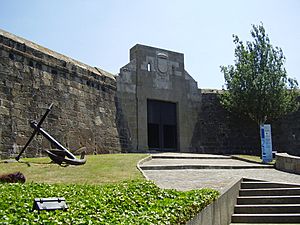History of A Coruña facts for kids
A Coruña (also called Corunna) is a city in Galicia (Spain). It sits on a piece of land that sticks out into the sea, at the entrance of a large bay. This bay was known as the Portus Magnus Artabrorum by old geographers.
Contents
Early History
A Coruña grew from a small settlement between an island and the mainland. The oldest part of the city, often called the Old City, was built on the site of an ancient Celtic fort. People lived here from about 300 BC to 200 AD. These early people were called the Artabrians, and they gave their name to the area long ago.
Roman Times
The Romans arrived in this area around the 2nd and 1st centuries BC. Even Julius Caesar visited the city in 62 BC. The town started to grow, especially during the 1st and 2nd centuries, which is when the famous Tower of Hercules was built. However, after the 4th century, the population decreased. This was mainly because of attacks by the Normans, which made people move further inland.
Middle Ages
After the Roman Empire fell, A Coruña still had a port that traded with other countries. However, trade with the Mediterranean Sea slowly changed to trade with countries along the Atlantic Ocean. The city became smaller, mostly home to workers and sailors.
An old record from the 11th century, called the Iriensian Chronicle, mentions Faro do Burgo, one of A Coruña's old names. It says that King Miro gave this area to the church in 572.
The city was not much affected by the Arabian invasion of the peninsula. The biggest problem for the people of A Coruña during the Middle Ages was attacks by the Normans, also known as Vikings. In the 9th century, the Vikings attacked the city, then called Faro or Faro Bregancio, many times.
In 991, King Bermudo II began building military defenses along the coast. A fortress with soldiers was built at Faro, using the old ruins of the Tower of Hercules. To pay for this, the king gave control of the city to the bishop of Santiago. The bishop became a very important leader in Galicia until the 15th century.
In 1208, King Afonso IX officially re-founded the city, calling it Crunia. He gave the city a special right to unload and sell salt without paying taxes. This helped the city's fishing and trading businesses grow a lot. The city expanded across the peninsula. In 1446, King Xoán II gave A Coruña the title of "City". The Catholic Monarchs later moved the main court of the Kingdom of Galicia to A Coruña, instead of Compostela. A Coruña also became the headquarters for the General Captain.
Modern Era
Carlos I met with important leaders in A Coruña before he was made emperor. Between 1522 and 1529, the government of Galicia was allowed to trade spices in Europe. Trade with the Indies (the Americas) was also allowed from 1529 to 1575. To protect the city, the Castle of San Antón was built.
From A Coruña's port, Philip II sailed in 1554 to marry Mary Tudor. In 1588, the famous Invincible Navy also left from here. The next year, Francis Drake tried to attack the city, but he failed, and the English soldiers had to leave on May 19.
During the 16th and 17th centuries, many wars fought by the Spanish monarchy led to higher taxes and forced people to join the army. In 1620, Philip III created a school for young sailors. In 1682, the Tower of Hercules was repaired by Antúnez.
19th Century

On August 19, 1815, Juan Díaz Porlier, a leader known as "O Marquesiño," spoke out against King Fernando VII. He wanted to defend the Spanish Constitution of 1812. Many business owners and thinkers supported him. But on August 22, he was betrayed. Two months later, he was executed. In all the rebellions of the 19th century, A Coruña supported the side that wanted more freedom and change. A Coruña was also very important in the Rexurdimento, a movement to bring back the Galician language and culture. The Galician Royal Academy was founded there in 1906, and the Brotherhoods of the Galician Language in 1916.
During the Peninsular War (also called the Spanish independence war), Sinforiano López led the resistance in A Coruña. A Coruña was the only city in Galicia that fought well against the French army. On January 16, 1809, in the Battle of Elviña, the French chased the English troops who were leaving. The English general, Sir John Moore, was killed. The French troops left Galicia by the end of May.
In 1804, the National Factory of Cigarettes was created in A Coruña. This is where the workers' movement in the city began. Throughout the 19th century, other businesses slowly started, including those making glass, textiles, gas, and matches. Trade by sea and people moving to the city attracted investments from Catalan, Belgian, French, and English companies. The Bank of A Coruña was founded in 1857. A new way of dividing the provinces in 1832 also helped the city's economy grow.
20th Century
At the start of the 20th century, A Coruña had about 45,000 people. After the 1960s, the city's businesses grew again, thanks to people like Barrié de la Maza who started companies like Banco Pastor and Fenosa.
Elections of 1931
In the Spanish general elections of 1931, all the political parties knew that the results would be very important for the country's future. In A Coruña, the campaign for the monarchy was strong. However, groups that supported a republic, including ORGA, independent republicans, the Spanish Socialist Workers' Party (PSOE), and the Partido Radical Socialista, worked together.
In the elections, the republican parties won 34 out of 39 council seats. The ORGA and the Partido Radical Socialista had the best results.
During the Dictatorship of Francisco Franco
After the Spanish Civil War, many people who supported the republic had to leave the country, and those who stayed faced difficulties under the new government. People who supported the new government took over many positions. During this time, some people from A Coruña were sadly affected by events in places like Mauthausen.
A group of people who supported the new government, led by Pedro Barrié, bought a large house called the Pazo de Meirás. They gave it to the leader for his summer holidays.
Democracy Returns
From 1983 to 2006, Francisco Vázquez Vázquez (from the PSOE party) was the mayor of A Coruña. During his time, the city became more focused on services. He was sometimes criticized for his views on the galician language and his city planning. On January 20, 2006, Paco Vázquez became an ambassador in Vatican City. Javier Losada took over as mayor. Today, the local government is a partnership between two left-wing parties, the Socialists' Party of Galicia and the Galician Nationalist Bloc.
See also
- Timeline of A Coruña
- Battle of Corunna
- The Siege of Coruña
 In Spanish: Historia de La Coruña para niños
In Spanish: Historia de La Coruña para niños



